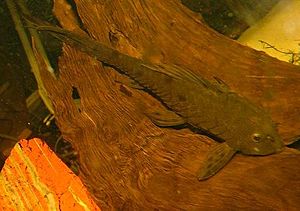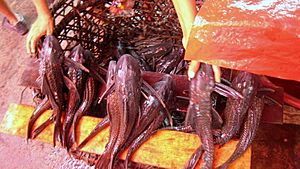Pineapple pleco facts for kids
Quick facts for kids Pineapple pleco |
|
|---|---|
 |
|
| Scientific classification | |
| Genus: |
Pseudorinelepis
|
| Species: |
genibarbis
|
| Synonyms | |
|
|
The Pineapple pleco, officially called Pseudorinelepis genibarbis, is a type of armored catfish. These unique fish live in the Amazon basin in countries like Brazil, Peru, and Ecuador. They get their common name, "Pineapple Pleco," because their tough, spiky armor plates look a bit like the skin of a pineapple!
What Does It Look Like?
The Pineapple pleco is a big, strong catfish. It can grow to be about 35.6 centimeters (around 14 inches) long. Its whole body is covered in thick, bumpy armor plates. These plates are very strong and protect the fish.
Unlike many other armored catfish, the Pineapple pleco doesn't have a small, fleshy fin called an adipose fin. Also, it doesn't have the special "omega iris" eye shape that most Loricariids have. In Peru, people sometimes call it carachama sin costilla, which means "armored catfish without ribs." This is because, like some other related catfish, it doesn't have ribs past its sixth backbone.
These fish come in many different colors! Some are completely dark brown or black. Others might be mottled, meaning they have a mix of tan and dark brown with black stripes. You might also see them in light tan with big, spread-out spots on their sides, fins, and belly.
Male Pineapple plecos have longer and thicker spikes, called odontodes, on their cheeks than females. Some people think that breeding males might also have orange colors on their cheeks and on the spines of their dorsal (top) and caudal fin (tail) fins. This orange color might be seen in fish from the Branco River.
Where Does It Live?
The Pineapple pleco lives in different types of freshwater environments. You can find them in small, slow-moving streams, in lakes that form on floodplains, and in large rivers. Scientists have checked the water where these fish live. They found that the water often has low oxygen levels, but it's usually neutral, meaning its pH is around 7.0.
This fish has a cool trick: it can swallow air! Many armored catfish can do this. However, the Pineapple pleco doesn't have to breathe air to survive. If it gets scared or disturbed, it can gulp air to help it float easily in the water. This lets it swim higher up in the water instead of staying at the bottom.

Pineapple Plecos as Pets
Since the 1990s, the Pineapple pleco has become a popular aquarium fish. People often call it a "Pineapple Pleco" because of its spiky armor, which looks like a pineapple. Even though it's called a "pleco," it's not actually from the old Plecostomus genus. Fish keepers also know it by special codes like L152 and L095.
The different colors of these fish can sometimes be confusing. Some males have orange cheeks, which is why another common name is "orange cheek Pleco." Interestingly, these fish can slowly change their color to match their surroundings. If they live in a tank with a dark bottom, they will gradually get darker. If the bottom is lighter, they will lighten up. This change takes hours or even days, so they don't change color instantly like a chameleon. It's a helpful way for them to hide from predators.
For people who keep fish, the Pineapple pleco is known to be a peaceful and friendly fish. They get along well with other fish of their kind and don't try to claim a specific area as their own. They eat many different kinds of food, so they are omnivorous. They do best in soft water, but they can also live in water with a pH up to 7.5. The water temperature should be between 23-27 °C (73.4-80.6 °F).
It's been hard for people to get these fish to lay eggs in aquariums. It's also a bit tricky to tell males and females apart. Females usually have a slightly rounder body shape. Males might have those orange "cheeks," which refers to the gill cover.
Unlike most other armored catfish that stay at the bottom, the Pineapple pleco will sometimes swim upside down to eat fish flakes from the water surface. As mentioned before, they can gulp air to get oxygen, but they don't need to because their gills work perfectly fine. So, if your Pineapple pleco starts gulping air often, it's a good sign that the oxygen in your tank might be too low.
See also
 In Spanish: Pseudorinelepis genibarbis para niños
In Spanish: Pseudorinelepis genibarbis para niños
- List of freshwater aquarium fish species

